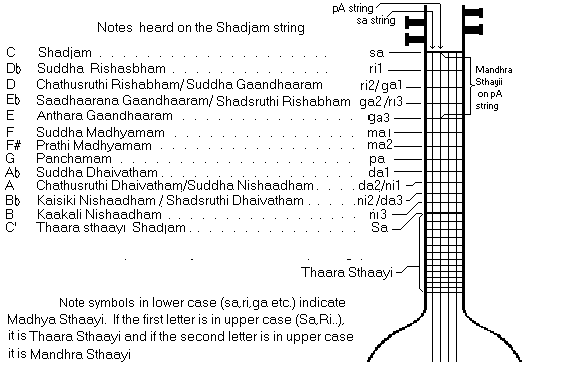
The ri ga combination is calculated from the table number. Melams 1 to 6 are in table no. 1, melams 7 to 12 are in table no. 2 and so on. Though there are 12 tables they are broadly divided into 2 groups with only the ma differing. Table no. 1 and table no. 7 will have all notes identical except ma. Here is a simple method to find out the Table No. and position of the Melam in the Table. If M is the Melam number divide (M-1) by 6. Adding 1 to the quotient of (M-1)/6 will give the choice number for ri,ga as illustrated in the previous page. This is the Table number. Adding 1 to the remainder of this division will give the choice for the da,ni selection. This is the position of the melam in the table. If the melam number is in the 1-36 range lower ma is used, else higher ma is used. To see how this works click here, enter the melam number and cllick OK.
If you are a music student and have developed swara jnyanam, here is a Melam Quiz for you.
Some positions like the first ri and the last ga, the first da and the last ni and the 2 ma's have unambigous symbols Other positions have dual names. The ga of tables number 1 is in the same position as ri in tables number 4 and 5. Ga of tables 2 and 4 becomes ri in table 6.
Venkatamakhi has explained this by a nice analogy (slokams 19 to 27, Melaprakaranam of Chathurdandiprkasika, Music Academy edition - available only in Sanskrit). If a person has 4 sons the 2nd is elder (jyeshta) if he goes with 3rd or 4th son and he is younger (kanishta) if he goes with the 1st son. Similarly if the 3rd son goes with the 4th he is elder and if goes with the 1st or 2nd he is younger. But the 1st son is always elder and the 4th is always younger. This is preceisely what happens here. The 2nd and 3rd position notes get the symbol ri or ga depending upon whether the 1st or 4th is used. There is no problem in understanding this if we look at the notes as sounds heard with some pitch and that ri,ga etc are only symbols not heard when singing the lyric or playing on an instrument.
The 12 positions also have official names. Starting from Sa (Shadjam), Suddha Rishabham, Suddha Gaandharam OR Chathusruthi Rishabham, Saadhaarana Gaandhaaram OR Shadsruthi Rishabham, Anthara Gaandhaaram, Suddha Madhyamam, Prathi Madhyamam, Panchamam, Suddha Dhaivatham, Suddha Nishaadham OR Chathusruthi Dhaivatham, Kaisiki Nishaadham OR Shadsruthi Dhaivatham, Kaakali Nishaadham. See them on a Veena sketch or Keyboard sketch (with C as sa).
The simple scheme of 32 melams based on 2 alternatives for ri,ga,ma,da and ni got expanded to 72. The additional 40 Melams are termed as Vivaadhi Melams. Any Melam having Suddha Gaandhaaram, Shadsruthi Rishabham, Suddha Nishaadham or Shadsruthi Dhaivatham is a Vivaadhi Melam and only a handful of them are commonly sung (Naata from Chalanaata, Varaali from Jhaalavaraali).